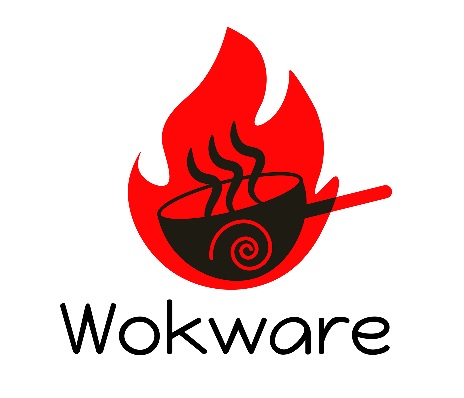Updated on April 2023
Electric Wok Vs Wok Pan (Which one should you buy?)
Wokware is reader supported. When you buy through links on our site, we may earn an affiliate commission. Learn Here.

Summary:
A traditional wok is always better than an electric wok for proper stir-frying. But in terms of ease of use and maintenance, an electric wok is preferable, as a wok pan needs regular seasoning and a high BTU wok burner, whereas electric woks already come with a readymade nonstick surface and heat source.
Electric wok vs wok pan - which one should you pick? Here's a detailed comparison between them.
Let's first understand the basic difference between these two.
What is a Traditional Wok pan?
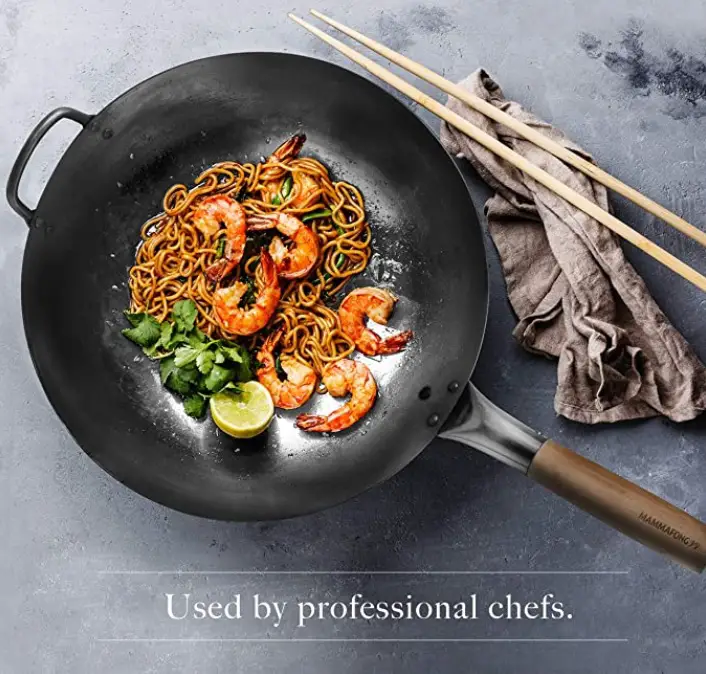
A wok is perhaps the most popular Chinese cooking appliance that has survived the test of time. Having used centuries back for the first time, woks have proven to be one of the most versatile cooking appliances that can do a lot more than delicious stir-fries.
Here's an article on 11 things you can do with a wok.
The typical shape of a wok has a round bottom (available in flat-bottoms too to suit all types of stovetops) and high slopes. A round bottom wok with a long wooden handle is often known as pow wok and the most favorite of Chinese chefs. Food glides through the slopes of the wok into the bottom and high heat brings out the smoky flavor while occasional tossing of the food makes it evenly cooked.
Woks also have evolved over time, adjusting to the changing needs of human beings. There are hundreds of different shapes, sizes, and materials to choose from, like carbon steel woks, cast iron woks, stainless steel woks, electric woks, nonstick woks, round-bottom woks, flat-bottom woks, etc, and it is, of course, confusing to pick one when you have a number of choices.
What is an Electric wok?
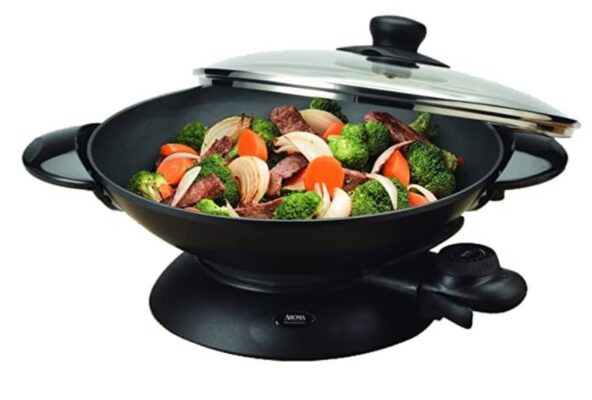
The electric wok is nothing but a wok that runs on electricity. A heating element comes attached with it and the wok sits over it. With the help of a radial dial, you can control the temperature of the wok ranging from simmer to high heat. Other cool features may come included with the wok as the price point rises.
Electric woks have gained much popularity in the last decades, owing to the ease of use, versatility, and maintenance.
There are a few features that make electric woks appealing, and there are also a handful of features that make traditional wok pans worthy of buying. The tiebreaker is our needs and preferences.
This article is aimed at answering all the questions regarding them – the maintenance, quality, durability, usage, price and user experience, to help you find out the best choice in the battle of Electric Wok Vs Wok Pan.
Electric Wok Vs Wok pan: Shapes, Sizes, and Material Comparison
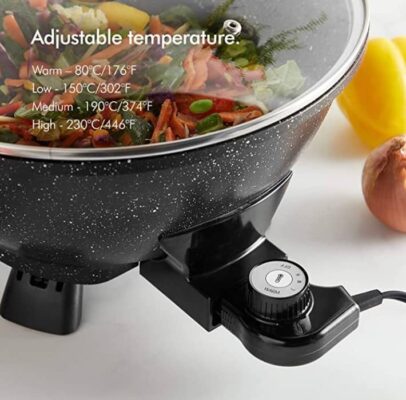
An electric wok as mentioned before, is simply a wok that uses electricity to heat up and cook, while a traditional wok uses fire to heat up.
Sizes: Electric Wok Vs Wok Pan
Both electric woks and traditional woks available in a variety of sizes, shapes, and materials.
Electric woks are usually sized up to 14 inches (diameter) with an 8-quart or less capacity which can serve up to 5 people, whereas stovetop woks can range more than 28 inches and the smallest of them is 6.25 inches. And the best choice depends on how many members are going to have the delicious wok-cooked food.
But the standard size for both electric and traditional wok is 14 inches. And you will get more variety and options in this size. Sometimes the size is mentioned only in quarts. In that case, a 7 quarts wok makes enough for about 3 – 4 servings, and a 5 – 5-quart wok makes enough for about 1 – 2 servings.
| Capacity Of a Wok (Electric/Regular) | Servings |
| 5 quart | 1-2 servings |
| 7 quart | 3 – 4 servings |
| 8 quart | 4 – 5 servings |
Shapes: Electric Wok Vs Wok Pan
Coming to the shapes, the best shape for woks is round-bottomed, which heats up faster, distributes heat more evenly throughout the pan, and reduces the oil requirement.
If you have a gas stove or burner and want to enjoy an authentic wok cooking experience, I will highly recommend you to go with a carbon steel round bottom wok. Carbon steel is the best material for traditional wok and preferred by chefs all over the world.
This 14 inch traditional pow wok from Craft Wok is made of authentic hand-hammered carbon steel wok and one of a kind. It has got a huge number of positive reviews on Amazon and owned and treasured by many chef-friends of mine.
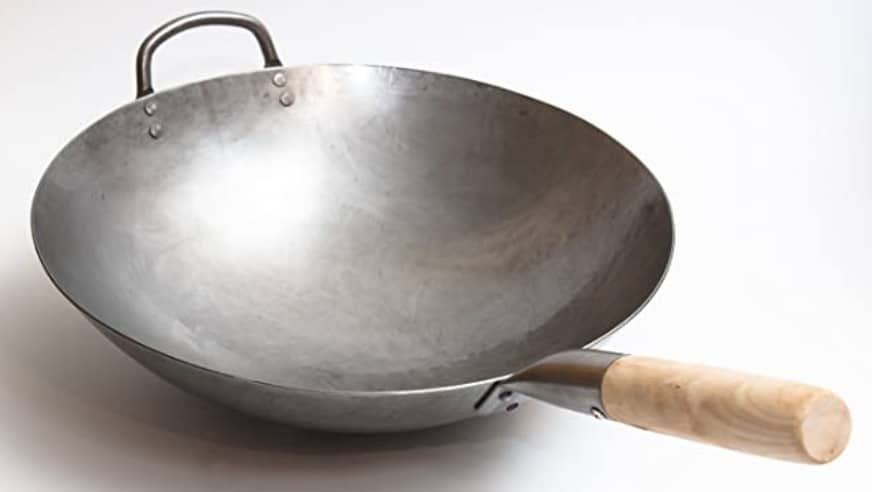
Traditional woks now come in flat bottoms too. Because with a flat bottom, you can place your wok on any stovetop. This is a very popular induction-safe flat bottom stainless steel wok from Cooks standard that I recommend for beginners who don’t love frequent seasoning and tough maintenance process of a carbon steel wok. It has a dome lid and an aluminum core, both of which are very useful.
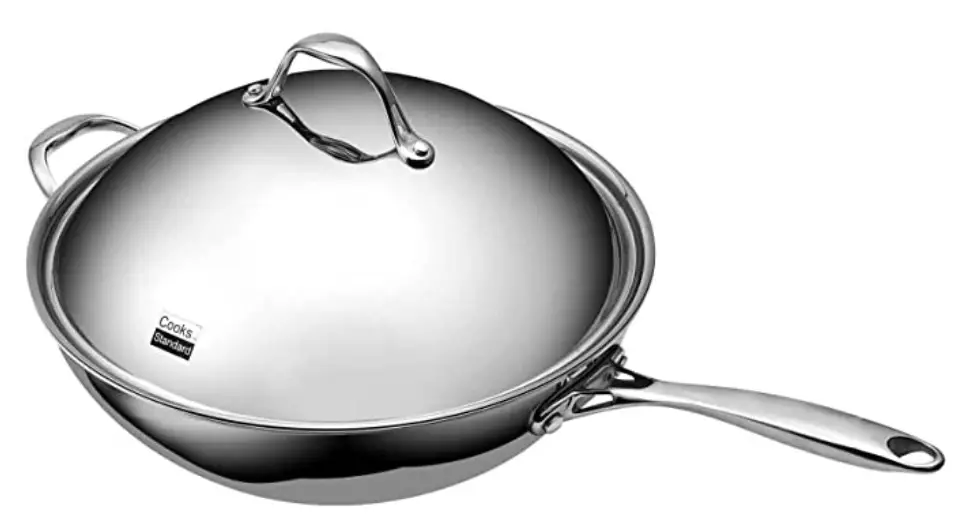
On the other hand, electric woks are available in mostly single shapes like the below Presto 1500 watt electric wok. It is the most popular electric wok in a budget. You don’t get much variety with an electric wok but it definitely gives you the suitability of cooking anytime and anywhere.
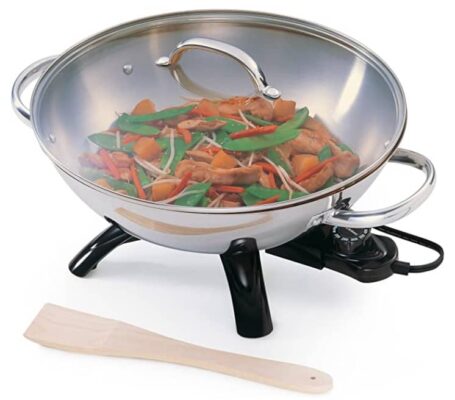
Verdict:
For those who don’t have enough space in the kitchen, live alone, or lead very busy lives yet want to eat safe and healthy food, I recommend you to go with the Presto electric wok. Stainless steel is safe, naturally nonstick, and will not need a lot of oil. This electric wok is easy to clean, comes ready to cook, will not take up space in your kitchen, and also doesn’t need you to do seasoning and all the hassle that comes with a traditional wok.
Now if you want a traditional and the most authentic wok cooking experience, where you will do all the flipping, tossing, and turning, a round bottom wok is perfect for you. However, for induction, ceramic or electric stovetop you need a flat bottom wok. Also, you cannot do the tossing if you don’t have an open fire. Surely you can enjoy healthy wok-cooked stir fry without tossing on your glass or ceramic stovetop.
Material: Electric Wok Vs Wok Pan
Electric and regular woks both are available in materials such as Aluminum, Stainless steel, Carbon steel, Cast iron, etc.
Some of the regular woks have a non-stick coating. It avoids the need for seasoning the wok every time before cooking. Thus increases ease of use.
Almost all electric woks include a non-stick surface. As not every coating is safe to use on high heat, you need to be very cautious while selecting a non-stick coated wok.

My recommendation is to always avoid a nonstick coated wok, especially because wok cooking is a high-heat cooking technique and nonstick will not last for long apart from being unsafe.
The cast-iron and carbon steel made regular woks without a non-stick coating are best suited for high-temperature stir-fry cooking. Carbon steel is lightweight, easy to handle and care for, great at heat distribution and conduction. The traditional hand-hammered carbon steel woks are the most authentic, durable, and healthy woks.
The best flat bottom carbon steel made hand hammered wok is by Mammafong (Amazon link).
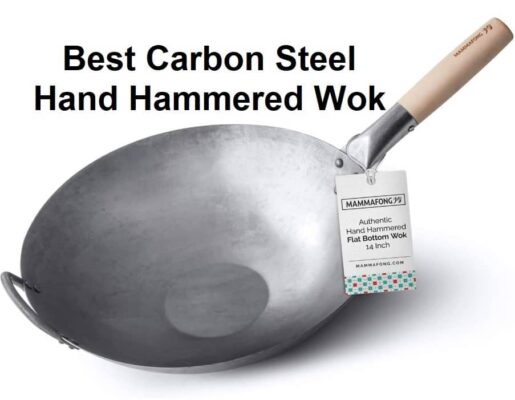
This wok is the special favorite of Chinese Chefs and highly popular because of its durability on high heat. Also, stir-fries taste the best when cooked at 100k – 150k BTUs, which can be attained only in a traditional stovetop wok and not in an electric wok.
Clearly Electric Wok has some limitation and regular wok would be a great choice here.
But, to be honest, not all of us have an outdoor kitchen or a high BTU wok burner to cook in such high heat. Our induction, electric, or gas stoves in that matter are unable to create such high BTU flame.
Verdict:
So, if you have an indoor kitchen using a good quality electric wok will generate higher heat than a regular wok on an induction/electric oven. Not only that, but the Electric woks are also placed in the heating probe in such a manner that the entire wok gets evenly heated. And your food cooks tastier while keeping all the flavors intact. Presto manufactures the best built-in heaters for electric woks.
Electric Wok vs Wok Pan: Usage Comparison
As mentioned earlier, woks can do a lot more than delicious stir-fries, like steaming, deep-frying, pan-frying, braising, searing, stewing, smoking, etc. Electric woks also can be used for all these purposes.
However, electric woks have some limitations here. The actual taste of stir-fries is in the temperature at which it is cooked. The higher the temperature, the better it will taste.
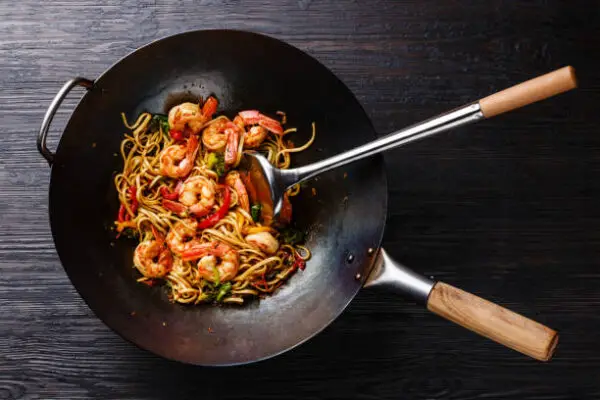
The electric woks cannot heat up as well as a stovetop wok, and the temperature is always limited by its design (condition is you are generating heat with a wok burner for the traditional wok).
This does not mean that you cannot make stir-fries in it – you can still make stir-fries, but it will not be as tastier as those Chinese restaurants.
If your primary aim is to cook great stir-fries and cannot compromise on taste, you should go for a traditional wok and a high BTU wok burner.
But at the same time, electric woks are highly portable. You can cook almost anywhere if you have a power outlet, which makes it a go-to option for small houses, confined spaces, or military camps. Many electric woks are detachable from the heating probe, so you can serve the food directly from the wok itself, just like the regular woks.
As the wok will be attached to the heating probe, another disadvantage of an electric wok is that it can’t be used to toss food which brings the authentic ‘wok-hei’ flavor in stir-fry while on high heat.
Verdict:
Comparing Electric wok vs wok pan in terms of usage is a little bit tricky. Both have their convenience and inconveniences. But I will suggest you to first have a definite answer to the following –
- Do you have a wok burner to generate high BTU?
- Do you want to toss your food?
- Do you have enough space for an electric wok?
Do you have a wok burner to generate high BTU?
If you have a wok burner, close your eyes and go for a round bottom carbon steel or cast iron wok. It will be the best choice to have. The hand-hammered one I have mentioned before will be a worthy investment.
In case you haven’t then you need to consider the following to choose between a regular wok pan and an electric wok.
Do You Want To Toss Your Food?
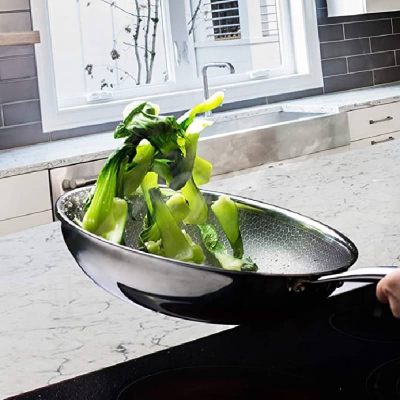
Tossing is not a must, but the sole idea behind cooking in a wok is to generate the ‘wok-hei’ flavor in the food. The accumulation of high heat, fast cooking, and tossing make all the difference in the taste of a restaurant and home-cooked meal.
Flat bottomed shallow wok pans demand tossing to cook the food evenly. Round bottom and deep curvatures of a wok will be perfect for cooking food from every side, given the heat source is enough to evenly heat the sides walls. Still tossing will be a good idea.
An electric wok is different than a traditional wok. Although the heating element is designed in such a manner so that the sides of the wok and the bottom heats up equally, for the perfect generation of ‘wok hei’ the temperature is not just enough. Also tossing is impossible.
Do you have enough space for an electric wok?
The most standard size of an electric wok is 14 inches in diameter. Traditional woks can be found in bigger sizes too. If you are using a small kitchen, then you probably have a dedicated place for the stovetop. So using a traditional wok pan will not need extra space.
Whereas, in case of electric woks, you need to make some extra room on the counter and find a safe place to use it. Some budget-friendly electric woks come with really short chord. In that case you will be needing an extension. Overall, to use an electric wok you must ensure you have the perfect place to set it up.
Electric Wok vs Wok Pan: Maintenance Comparison
Maintaining the wok well is important to get the maximum life out of it. All Electric woks and some wok pans are easy to maintain, especially the ones with non-stick coatings.
Non-stick coatings make cleaning and cooking a lot easier since it prevents food particles from sticking to the bottom of the wok. However, if your wok has a coating, you shouldn’t heat it to temperatures above 500°F, as it can decompose the coating.
This applies to all non-stick electric and traditional woks. Also, metal utensils can’t be used on non-stick surfaces due to the chances of untimely chipping. Wooden spatulas are the only solutions.
Cleaning and Storing: Electric Wok Vs Wok Pan
Traditional cast iron and carbon-steel woks without the non-stick coating need extra care. From seasoning, the wok to cleaning and storing it takes a lot of work.
The wok may undergo rusting, and to prevent that, you should season it occasionally. If you cook regularly and season it every time before cooking, a non-stick layer will form on the surface with time. Also, they can be used for high-temperature cooking without any issues. In fact, Chinese restaurants mostly make stir-fries in traditional cast iron woks.
For the cleaning process, if you let the fat sit on the carbon steel and cast iron wok, it will be harder to clean. Instant serving the food after cooking is the best way to make your cleaning process easy. You will need an abrasive, a good scrub pad, and some hot water to keep your regular wok clean.
Verdict:
If you compare, electric wok vs traditional wok on maintenance, the electric wok is a winner here. All you need is a dishcloth to wipe out the leftover food from the electric wok, and the remaining temperature post-cooking will be enough to sterilize the wok.
But to clean and maintain a traditional wok without coating you need to put considerable effort. Although most woks come in dishwasher-safe material, I consider any cookware over $100 as an investment hence spend time and effort to keep it clean and well-maintained.
Electric Wok Vs Wok Pan: Price Comparison
Electric woks and traditional woks are available in a range of prices.
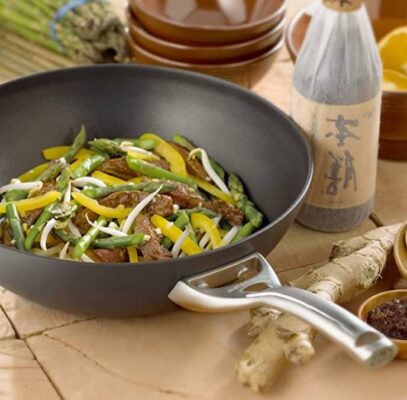
High-end traditional woks that are loaded with features, sleek design, and durable material may cost you $100 – $300. To get a generous quality, pre-seasoned wok you will need to spend at least $40 – $80. Anything below that may not have a pre-seasoned or safe non-stick coating or durability in that matter.
However, Chef Raven Lee has curated a list of cheap woks around $40 which are safe for regular use and a great choice if you are low on budget.
It should be noted that he has also emphasized the fact that, buying a high-end wok will be the right decision if you can extend your budget a bit in terms of long term usage.
A good quality electric wok may cost you anything between $100 – $200. There are affordable electric woks too but you need to compromise on some useful features.
Electric Wok Vs Wok Pan: Buyer’s Experience Comparison
A comparison is not complete until the user experience is taken into account. As a part of this research, I and the entire team of Wokware has talked with many electric wok and traditional wok owners, cooks, and analyzed the reviews from Amazon to find out the best choice.
Most agreed that stir-fries taste the best when cooked in traditional cast iron or carbon steel wok. Grace Young, author of ‘Stir-frying to the Sky’s Edge’, said about regular wok that
“The old fashioned way is the simpler way and more practical. It does what you need”.
Eileen Lin-Fei Lo, the author of ‘Mastering the Art of Chinese Cooking’, also insisted that traditional stovetop woks are better for stir-frying.
However, it is only in the case of stir-fries. Electric woks are as good as traditional woks for steaming, stewing, etc, reckons reviews on Amazon.
Electric woks heat up only up to 500°F, and that seems to have disappointed many owners who wanted to cook great stir-fries. At the same time, many praised the portability, ease of cooking and cleaning. Customers seem to like the electric woks that have detachable heating probes.
Final Verdict
So, who is the winner in the wok vs electric wok comparison? We saw that electric woks and regular woks, both are priced around the same range, break even on the maintenance, and are available in the same shapes, sizes, and materials.
The traditional woks have a slight advantage here since they make better stir-fries. At the same time, they need a little extra care, whereas electric woks are easy to clean, maintain, and are as good as traditional woks to cook stews, soups, and pan-fries. Having a detachable heating probe adds a little extra to the portability.
For someone looking for great stir-fries, regular wok is the go-to option. For those who would like to have a portable wok to cook stews, soups and occasional stir-fries, electric woks might be enough.
At the end, it is your need and convenience which will end this war of Electric wok vs wok pan and give you the right appliance to invest in.
P.S: I bought a wok. It serves me well. But recently, I thought of trying an electric one, and guess what I am using an electric wok too! However, with a regular wok, you get to experiment with a lot of dishes but an electric wok may restrict you on that. So, if you are a beginner, I will recommend you to buy a regular wok. After you get the hang of it, get yourself an electric wok (not a must but a luxury to have and I love my kitchen to have versatility 😀 )
More Resources to Read:
- Cast iron or Carbon Steel Wok – Choosing the better Wok
- Stainless Steel Wok Vs Carbon Steel, Cast iron, Aluminum, Nonstick Wok – Detailed Analysis
- Does your wok need a lid? Which is the best type of lid?
- Do Joyce Chen Woks Worth the fame? Debugging Myths
- Is Lodge Cast Iron Wok Any Good? My Honest Review
- Wok or Dutch Oven – Which is worth buying?

Best Carbon Steel Wok Recommended by Wokware
Mammafong 14 inch Traditional Hand Hammered Round Bottom Carbon Steel Pow Wok Set
Author: Preeunka
Editor at Wokware
She is an expert in the niche of kitchenware for 10 years now. She has given readers fact based, well researched, to the point answers of their valuable questions. Her goal is to simplify kitchen products and their utilities.
